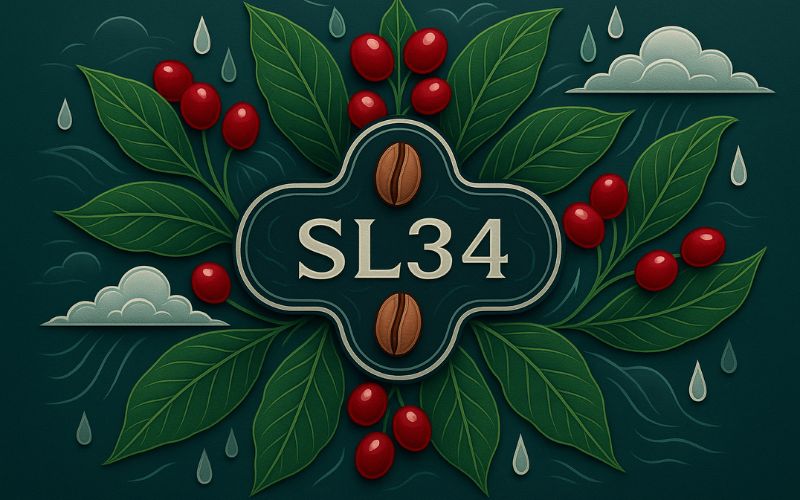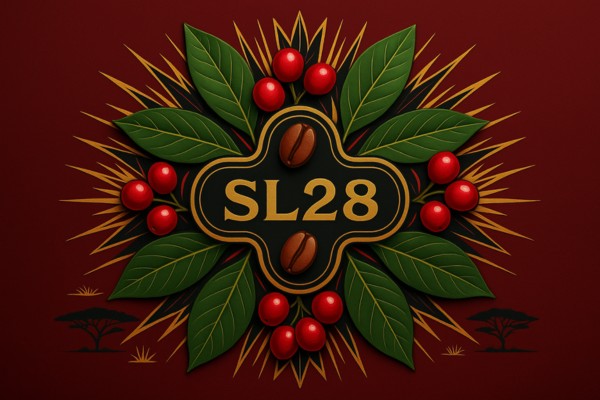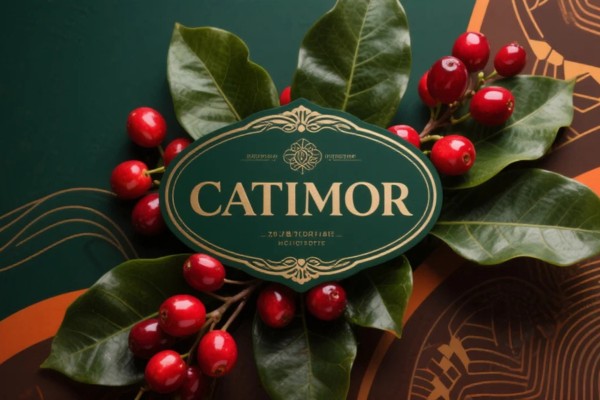
SL34: The Other Star of Kenya
Explore the story of SL34, a key coffee variety selected by Scott Laboratories in Kenya alongside the famous SL28. Learn about its origins, its reputation for a heavy, elegant body, and its classic flavor profile of stone fruit, complex acidity, and rich mouthfeel that perfectly complements SL28.
SL34: The Dependable Counterpart to SL28
While SL28 often gets the spotlight for its intense and unique flavor profile, SL34 is an equally important part of the classic Kenyan coffee equation. Selected by Scott Laboratories around the same time as SL28, SL34 was chosen for its higher yields and excellent cup quality, which is subtly different from, yet highly complementary to, its famous sibling.
SL34 is known for producing a cup with a heavier body, a more rounded acidity, and a complex sweetness. Many of the best Kenyan coffees are actually a mix of both SL28 and SL34, which together create a cup of incredible depth, complexity, and balance.
Like SL28, SL34 plants are tall with broad leaves, and they are well-adapted to growing at high altitudes in Kenya's rich volcanic soils.
A Selection from the "French Mission" Lineage
The story of SL34 is part of the same Scott Laboratories project that gave us SL28. In the 1930s, researchers were looking for coffee varieties that would thrive in Kenya.
The selection that became SL34 was made from a single tree found on the Loresho Estate in Kabete, Kenya. This tree was part of a lineage known as "French Mission," which is believed to be a Bourbon variety brought to East Africa by French missionaries from the Île Bourbon (Réunion).
This gives SL34 a different genetic starting point from SL28, which was selected from the "Tanganyika Drought Resistant" variety. This difference in ancestry is key to the subtle but significant differences in their cup profiles.
SL34 was recognized for its good productivity and its ability to thrive at various altitudes, from medium to high. It quickly became a favorite among farmers and, along with SL28, was widely distributed across Kenya.
A Profile of Elegance and Body
The flavor profile of SL34 is often seen as the perfect partner to the sharp intensity of SL28. It brings a weight, sweetness, and elegance to the blend.
- Acidity: The acidity is still complex and bright, as is typical of Kenyan coffees, but it is generally more rounded and less sharp than SL28. It often has a distinct stone fruit or red wine character.
- Body: This is where SL34 truly excels. It is known for its heavy, rich, and often creamy mouthfeel. This gives the coffee a satisfying weight and presence on the palate.
- Aroma: The aromatics are typically sweet and fruity, with notes of brown sugar, dried fruit, and a hint of floral spice.
- Flavor: Look for a deep, complex sweetness and rich fruit flavors. Common notes include ripe plum, black cherry, and red grape, often with a clean, lingering finish.
When you taste a Kenyan coffee with a remarkably heavy and elegant body, you are likely tasting the influence of SL34.
Agricultural Traits: A Farmer's Friend
SL34 was selected not just for its cup quality, but also for its more favorable agricultural characteristics compared to other high-quality varieties.
- Higher Yields: SL34 is generally more productive than SL28, which made it an attractive choice for farmers looking to balance quality with a commercially viable yield.
- Adaptability: It is known to perform well at a wide range of altitudes and in different soil conditions, making it a versatile and dependable choice.
- Disease Susceptibility: Unfortunately, like SL28, it is highly susceptible to both coffee leaf rust and Coffee Berry Disease (CBD). This has led to it being partially replaced by more modern, resistant varieties in some areas.
The combination of great flavor and good productivity made SL34 a cornerstone of the Kenyan coffee industry for many years.
Key Growing Regions
SL34 is almost synonymous with Kenya, and it is here that it is most famously grown and where its classic profile is best expressed.
- Kenya: It is grown in all of Kenya's major coffee regions, such as Nyeri, Kirinyaga, Embu, and Murang'a. It is the combination of the rich volcanic soil, high altitude, and the unique Kenyan processing method (which involves a double fermentation) that allows the full potential of SL34 to be realized.
- Beyond Kenya: Like SL28, SL34 has been planted by quality-focused producers in Latin America in recent years. These coffees are helping to showcase the variety's inherent quality in different terroirs.
Brewing for a Rich and Rounded Cup
To highlight SL34's characteristic body and rich sweetness, your brewing method should be chosen accordingly.
- Recommended Methods: Immersion methods like the French Press or AeroPress are excellent for showcasing the heavy body of SL34. For pour-over, a brewer that tends to produce a fuller body, like a Kalita Wave or other flat-bottom brewer, can be a great choice.
- Grind and Ratio: A slightly finer grind or a tighter coffee-to-water ratio (e.g., 1:15) can help to emphasize the coffee's richness and deep fruit notes.
Conclusion: The Unsung Hero of Kenya
While it may not have the same level of instant name recognition as SL28, SL34 is in many ways the unsung hero of Kenyan coffee. It provides the weight, the balance, and the rich, elegant body that forms the foundation of the classic Kenyan cup profile.
It is a variety that offers both the farmer and the coffee drinker a remarkable combination of dependability and profound quality. The next time you enjoy a truly great Kenyan coffee, take a moment to appreciate the contribution of SL34 – the variety that gives the Kenyan king its crown.


